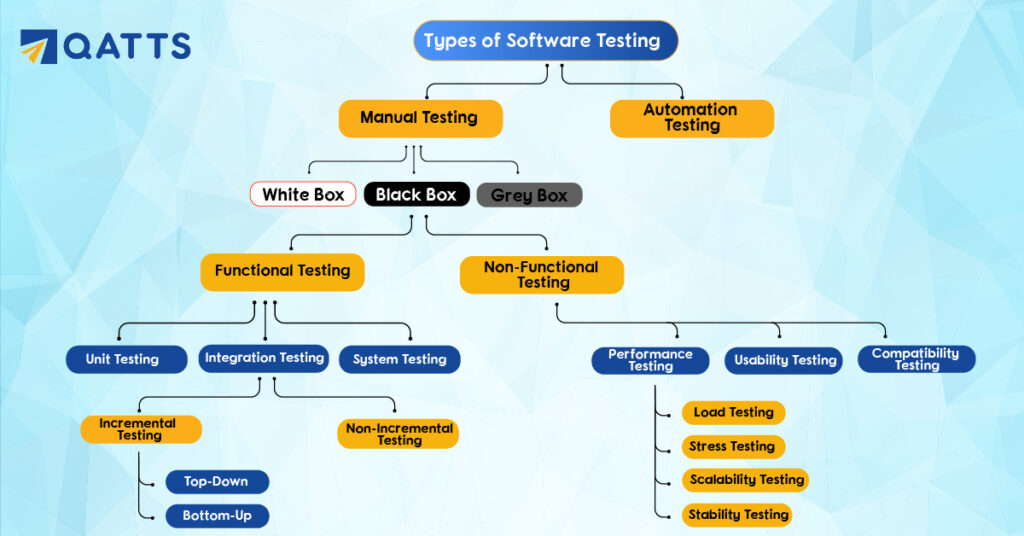
Introduction
Businesses require high-quality products and a faster time to market to compete in today’s market and reap profits. For this, we need to test the application and ensure it is bug-free. This is where software testing hails and plays a crucial role.
Let us know in detail from the basics.
What is software testing?
Software testing is a process of identifying and evaluating whether the developed application meets the Business Requirement Specifications through critical analysis. In addition to it, it evaluates the features and validates the app’s performance against the requirements at each stage.
Importance of software testing
Software testing plays a vital role in the software development life cycle (SDLC). Here are the reasons why it is important. Read on to know.
- It assures reliability, outstanding UX, and high-quality software. Thus, it provides better business optimization.
- It ensures applications and software are bug-free and robust which is most important for a product’s success.
- Bugs at each stage of the testing cycle can be detected and rectified. As a result, it will be easy to add new features without affecting the performance of the software.
- Also, it reduces manual efforts and save testers’ precious time.
- Moreover, these software testing services are budget-friendly.
Benefits of software testing in software development
Let’s discuss the advantages of software testing in software development.
- It improves the quality of the software or application. As a result, it enhances the customer satisfaction.
- With the help of software testing, you can deliver the error and bug-free software without facing any risks. Hence, you can safeguard your crucial data and gain the trust of your customers.
- As it reduces manual efforts, businesses can concentrate on their core business rather than testing the software or applications all the day.
- Also, we verify the functionality of the application or software continuously with software testing, it decreases the time spent on customer support.
- High-quality product gains high profits thus software testing brings in more ROI.
- Besides, it saves your precious money and time.
- Furthermore, well-organized testing strategies and efforts promotes productivity and efficiency.

Types of software testing techniques
These are the two types of testing that ensures your software or application is error or bug-free.
- Manual testing and
- Automation testing
#1 Manual testing:
Manual testing is defined as performing testing manually without the need of automation tools. Also, for testers, a minimum of in-depth knowledge is not required to perform manual test cases. It is of three types namely White-box testing, Black box testing, and Grey box testing.
Let’s discuss these manual testing types here.
- White box testing:
White box testing examines the internal structures of the program that includes the utilized data structures, internal architecture, code structure, and how it works. The developer will analyze each code line in this testing before passing it to the concerned test engineers or testing team.
- Black box testing:
The test engineer will inspect the software as per the business requirements to detect any bugs or defects in black-box testing. Then, they pass it to the team of developers. The development team will work on fixing the defects, later do white box testing and pass it back to the testing group. The intention behind performing this testing is to describe the user’s requirements or business needs.
Again, there are two types of black-box testing: Functional and non-functional testing.
Functional testing:
In functional testing, the tester will monitor all the components as per the specification of requirements. It is a part of black-box testing because it is more attentive to app needs than the original code. Here, the test engineer does not test the entire system but tests only the program.
Functional testing types –
- Unit testing:
It is the starting step where you test any app or software. In unit testing, the test engineer tests functionality of all modules or application modules independently. The primary purpose of this testing is to authenticate every unit component with the performance.
- Integration testing:
Integration testing is where the testers test the flow of information among dependent modules. It is performed to test the accuracy of statements between every module.
Integration testing types –
There are two types of integration testing, incremental testing and non-incremental testing.
Incremental testing:
In this testing, the testers add up the modules and test the data flow among the modules.
Incremental testing types –
- Top-down:
In Top-down incremental integration testing, the modules are added one after another or incrementally test the flow of data among the modules. The testers need to make sure that they add the child of previous ones.
- Bottom-up:
Modules are added incrementally in bottom-up incremental integration testing or by verifying the flow of information between the components. The testers have to ensure that they add modules of the parent of previous ones.
Non-incremental testing:
When testers feel that the flow of data is complicated to detect the child or parent module, at this point, testers use non-incremental testing. The Big Bang method is another name for non-incremental testing.
- System testing:
Once testers perform unit and integration testing, they can move on to system testing. It is also known as end-to-end testing. The testers analyze each software attribute and do testing to ensure the end features operate along with the business needs. And it thoroughly examines the total product system.
Non-functional testing:
Non-functional testing is the next part in black-box testing. It offers you entire information details of the product and the technologies used in it. Also, it will help you in minimizing software-related prices and production risk.
Non-functional testing types –
Here, let’s discuss the types of non-functional testing.
- Performance testing:
In performance testing, some load is applied by the test engineer while testing the working of an application. The tester will concentrate only on the characteristics such as load, response time, scalability, and stability.
Performance testing types –
These are the different types of performance testing, they are:
- Load testing:
Some load is applied to specific applications for checking the performance of an application in load testing. Here the load used might be more or equal to the actual load.
- Stress testing:
In stress testing, the testers analyze the software’s robustness and user-friendliness beyond the limits of standard functionalities.
- Stability testing:
The application’s performance is evaluated by applying some load for a particular time instability testing. It mainly verifies the efficiency and problems in the software quality. Even in stressful conditions, testers can find defects.
- Scalability testing:
In this testing, you reduce the load in particular situations and analyze the application’s performance. And the testers verify the processes, systems, and database ability to fulfill an upward requirement.
- Usability testing:
In usability testing, the testers test the application’s user-friendliness and find the bugs in the end-user interface of the software.
- Compatibility testing:
It determines if your software can run on a variety of hardware, operating systems, network environments, applications, and mobile devices. Also, it is performed to test the software application’s compatibility with various browsers such as Chrome, Internet Explorer, Firefox, Opera, Safari, and others.
- Grey box testing:
The collaboration of white box testing and black box testing is Grey box testing. And professionals who are adept at both coding and testing can perform this type of testing.
#2 Automation testing:
Manual testing does not suffice the need of faster TTM and high-quality products and hence, Automation testing plays an important role in software testing. It utilizes particular automation tools to detect bugs or errors without the involvement of a human.
With Agile and DevOps methodologies on the go, there is more demand for test automation with Continuous Integration (CI), Continuous Development (CD) and Continuous Testing (CT) all around. And this testing provides you with testing coverage, efficiency, and productivity.
In addition to the above list, there are a few other types in software testing as follows.
Smoke testing:
Before deep testing, smoke testing tests an app’s critical and essential features. The main intention of doing this testing is to analyze the application’s core workflow and significant functions.
Sanity testing:
This type of testing assesses the validity of newly added components and functionalities. As a result, it ensures that all flaws and defects have been corrected. Also, it verifies if any new issues have arisen. Moreover, as the testing is unscripted, you won’t be able to document it.
Regression testing:
Regression testing is a sort of software testing. It is used to ensure that a recent program or code modification hasn’t broken current functionalities. In other words, it is just a complete or partial re-execution of previously performed test cases in order to confirm that current functionality are working properly.
User acceptance testing:
The testing performed by the individual team as the client or domain customer, or expert. And knowing the app’s behavior before acceptance of the final product is user acceptance testing. Besides, this testing examines both business and real-time scenarios.
Security testing:
In security testing, the testers can identify software applications’ risks, threats, and weaknesses. Also, it will help us prevent the apps from outsiders and ensure that the application is secure.
Interface testing:
The term “interface” refers to a connection that connects two components. In the computer world, this interface could be anything from APIs to web services. Interface testing is the process of evaluating these connected services or interfaces. In other words, interface testing determines whether or not two software systems are communicating properly with one another.
Volume testing:
In volume testing, the tester analyzes the performance of a system by increasing the volume of data in the database. It is concerned with software that has to cope with a lot of data.
Install testing:
Also known as implementation testing, Install testing is performed to verify whether the software is rightly installed and all features are incorporated correctly or not.
Recovery testing:
Recovery testing is a testing activity to know how good a software application recovers from hardware failures, crashes, and other issues such as power supply failure, the external device not responding as expected or external server is unreachable, wireless network signal loss, etc.
Reliability testing:
Reliability testing is a technique for determining a software’s capacity to perform in a specific environment, which aids in the discovery of flaws in the software’s design and functionality. In other words, it assesses whether a software can operate without fail for a set period of time in a given environment. Besides, it assures that the product is reliable and flawless.
Compliance testing:
Also known as conformance testing, compliance testing is one of the nonfunctional testing techniques performed to verify and validate whether the developed system suits the prescribed standards of an organization. Also, it assures the correct implementation of specifications, interoperability, and portability. It also distinguishes between areas that must and must not be confirmed, such as syntax and semantics.
Localization testing:
The testers verify the software’s accuracy, suitability, and behavior for particular regions and locations in localization testing. And it could be from anywhere, like a city or an entire nation. Thus, it is the technique of testing how specific software behaves when utilized in various fields.
Conclusion
To survive in this competitive world and be a winner, you must provide high-quality products. And prioritizing the quality will have a major impact on your business and financial performance. Whether it be a startup or a large-scale enterprise, QATTS always focuses on software quality assurance, helps to enhance your organization’s development, and software testing procedure. Consequently, we deliver the best in the industry by covering key aspects that include strategic planning, a test-oriented quality management strategy, and a dedicated QA staff.


